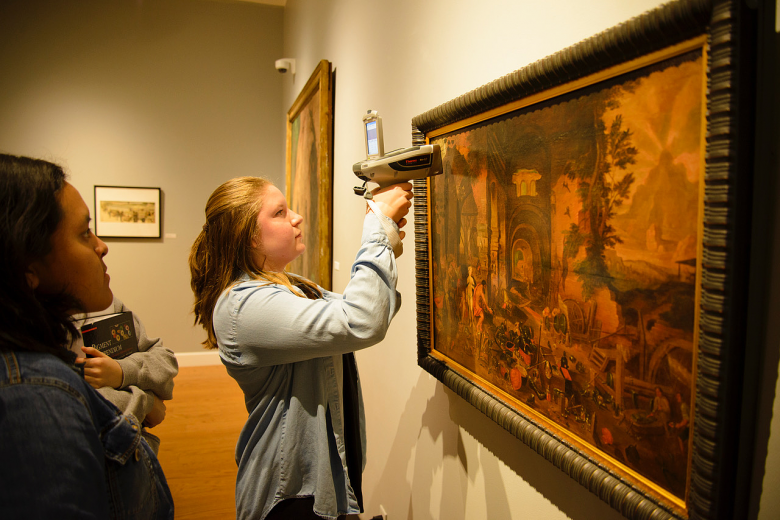Museum Monday: Science, Art, and Anthropology
The disciplines of chemistry, art, and anthropology came together to investigate art at the Wright Museum of Art.
This semester the disciplines of chemistry, art, and anthropology came together through collaborations facilitated by assistant professor Kristin Labby in her CHEM 225 / MUST 295 course “Instrumental Analysis of Art and Artifacts.”
In this course, students used the handheld X-ray Fluorescence analyzer at the Logan Museum to study the elemental composition of museum objects. Students found that ornamental metal discs attached to the textile were potentially tumbaga, a metal of gold-copper alloy, but were actually comprised of 30 percent silver and 70 percent copper, therefore not authentic tumbaga.
Kristin’s class then collaborated with Adjunct Assistant Professor David Boffa’s ARTH 150 “Italian Renaissance Painting” course for multiple combined-class activities such as making paint from scratch by mixing pigments (often a solid powder which provides the color) with various binders (liquid media which makes the paint spreadable and affixes it to the surface). Binders included oil paints, egg tempera, glair (egg white), watercolor gums, and acrylic. Chemists contributed information of the properties of the materials (why might you need to first mix the solid pigment in water before incorporating it into the binder?) while art history students contributed knowledge of what paint materials would have been available to artists over different time periods in history, such as in the Renaissance (roughly 1300–1600 CE).
In a two-day collaboration, the classes worked together to analyze paintings from the Wright Museum collection using XRF spectroscopy to identify metals present in various regions of the paintings. Since many pigments contain metals, and particular pigments were commonly in use at particular time periods, this analysis provides information on the history of the painting. For example, artists commonly prepared their canvas with a foundational layer of white called the ground. Lead white would have been the predominant white pigment from the Middle Ages until the 19th century when zinc white became more available and commonly used. Titanium white, a much safer alternative, was synthesized in the early 20th century and immediately predominated.
On the first day, students researched the history of the painting and generated thoughtful research questions and selected particular areas of the painting to analyze. On the second day, with the assistance of instrumentation specialist Rongping Deng, students then had a hands-on opportunity to use the handheld XRF instrument.
“While we, fortunately, did not reveal any major fakes or forgeries within the collection, we gathered valuable information that mostly confirms the attributions of the paintings we analyzed. For example, we identified that the School of Cranach’s Adoration of the Magi was painted on a lead white ground, consistent for its attributed time period. Also, it was exciting to confirm that the star is indeed real gold!” says Kristin.
Logan Museum Director and Curator Nicolette Meister highlighted that this type of collaborative work exemplifies the intersectionality of multiple fields: science, museum studies, anthropology, and art. Student Mustafa Quadir’20 says of Prof. Labby’s course “I hope more STEM faculty collaborate with other departments to build more courses like this. The overlap of science and humanities is where the future lies.”
Share:
Open gallery

Related Stories


